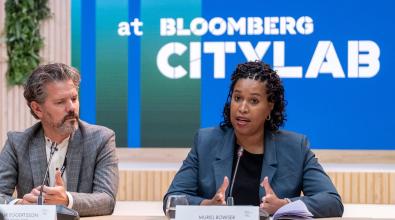How cities can flatten the curve again
As new cases surge, subside, and surge again, data tracking the efforts in six global cities provide lessons for municipalities everywhere

As we near the end of 2020, one thing is clear: This will be a year that is studied, researched, talked about, and remembered for centuries to come. Just as the flu of 1918 did more than 100 years ago, coronavirus has indelibly marked this moment in history. One of the most stunning parts of this past year is the incredibly important role that data has played in guiding policy decisions. Each of us watched as a tidal wave of red dots circled the globe—first approaching our home countries and then our hometowns. Every morning since then, we’ve started the day by checking public-data resources to see if it’s safe to leave the house, send our children to school, see our loved ones, and return to our workplace. Data sits at the intersection of some of our most rapidly evolving public policies, ruling our days and dictating our present and our future. But what have the data taught us, what do we still need to learn, and how are we adapting our behavior to match the demands of this seemingly relentless virus? So far, the answers to those questions depend largely on where you live. The data visualization presented here examines the pandemic response in six cities around the world—Milan, New Orleans, New York City, São Paulo, Wuhan, and Johannesburg —with the aim of shedding light on how public policy helped guide the local response. As you’ll see, some of the most influential factors in slowing the spread of COVID-19 have emerged from public policy decisions that focused on these key areas:
- Closures and Curfews Difficult in the short term but beneficial in flattening the curve of the disease, closures and curfews were critical to stemming the tide of the pandemic. We can see this in New York City. When schools and nonessential businesses were closed in March, new cases declined a few weeks later. Reopening proved more difficult without transparent practices about when decision making would be invoked and a path back to restriction when cases, as they are now, surged. But safe reopening is possible if adequate consideration is given to masking and safe distancing.
- Widespread Efficient Testing and Contact Tracing: When we have testing widely available, with quick turnaround on results, we can get a great sense of who has the disease and trace their contacts. The faster we can get exposed people in to quarantine the better handle we have on the disease. Cities that are thoroughly testing and tracing can more effectively support their residents, as they did in New Orleans where mortality remained low even as new cases increased over the summer.
- Mask Wearing: Cities that mandate masks and have good enforcement of masking policies in public spaces are able to significantly impact community-based spread. We see this in Wuhan, where the mask mandate not only helped them flatten the curve in February, it also has created the conditions for gradual reopening of the economy—without an uptick in new cases.
- Limiting Gatherings: As we head into the winter months (in the northern hemisphere) and the holiday season, we will want to be indoors where it is warm and with large groups of friends or family. Limits on these gatherings and clear public pressure to stay home and avoid indoor activities where masking and social distancing are impossible will save lives. In Sao Paolo, new cases continued apace during the colder months of July and August before declining in September as the climate warmed, suggesting increased challenges as the northern hemisphere braces for the cooler months.
Cities need to focus on developing the mechanisms for articulating responsive policies and the levers for enacting them. This includes accountability for people and institutions acting in a way that is not in the best interest of public health. This visualization both demonstrates the influence cities have in containing the virus—through policies and data-driven practices—and begs an important question: If we can dramatically stem the severity and spread of a novel coronavirus using data and public policy, what other systemic, deep-rooted challenges should we approach with the same focus, determination, and effort?
Cities are at the center of this global approach to curb the spread of the coronavirus.
In the absence of international or, in some cases, national leadership fueled by trusted public health policy, many mayors have been left with the impossible task of navigating this pandemic largely on their own. So how have they done? Here’s how the effort looks in six cities.
New York City
The epicenter of the U.S. outbreak of the coronavirus had a devastatingly rapid and sharp onset of the disease. In response, we saw the governor swiftly shut the economy and schools down. The mayor matched this sense of urgency by extending closures, repurposing industries to help in the proliferation of personal protective equipment for frontline workers, closing streets to car traffic, and regulating the movement of residents. These swift actions in late March allowed for hospital capacity to meet demand, and for the city to “flatten the curve” carefully and in a way that is sustaining when other cities around the U.S. were experiencing additional surges in the spread of the disease. In fact, three weeks after the closures went into effect, we began to see new cases fall.
New Orleans
A city that has grown accustomed to dealing with shocks to its systems, also was one of the U.S. cities that had a rapid onset of coronavirus at the start of the pandemic. While the progression was not at the same scale as New York City, it still demanded swift policy action. After an initial flattening of the curve—a response to citywide closures, stay-at-home orders, and restrictions on private gatherings—the city embarked on an ambitious reopening plan. The first phase of reopening was preceded by declines in cases, but reducing mortality lagged. Positive cases remained low during the first phase of reopening and then, during the second phase, the city expanded testing, which allowed for more surveillance on disease spread. And while positive cases increased during phase two, the daily deaths remained very low. This result provides further evidence that expanded testing when combined with targeted contact tracing proves to be an effective strategy for limiting the number of more serious outcomes like death.
Wuhan, China
Comparing this city—the global epicenter of pandemic at its outset—is difficult because data collections standards there have shifted. As a result, the data line shows a sharp increase and then a square-shaped line between April and May. Dramatic shifts in data are a warning of a potential problem and can undermine confidence in public health metrics and their interpretation. That said, Wuhan experienced one of the sharpest flattenings and has, according to its data, contained the disease. This containment without vaccination is credited to its swift policy actions—including shutting down the city, mandating masks, complying with public-health advice, initiating widespread contact tracing, and providing free and widely available testing.
Milan, Italy
The largest city in Italy’s Lombardia Region, Milan and its neighboring communities were the world’s second hotspot in early 2020. There is no publicly available data on the deaths in Milan but you can track the cases at the city level. Swift closures of the city and nonessential businesses in March sharply flattened the curve. With gradual reopening and the new school year, the cases started increasing in October. We are now seeing early evidence that policy actions, such as the national mask mandates and restrictions on in-person gatherings, are slowing the spread.
São Paulo, Brazil
This incredibly dense Brazilian city has been, and remains, ones of the most impacted cities in the world. The city swiftly implemented measures that closed businesses and schools and limited gatherings. Leaders also introduced a citywide mask mandate with penalties for those not in compliance. While cases here remain high, the reported death rate in São Paulo has been steadily lower than other cities with the same number of cases and density.
Johannesburg, South Africa
Johannesburg is another population dense city with a wide-ranging population. South Africa represents the highest level of Covid spread and death in all of Africa with Johannesburg accounting for a significant portion of the disease spread. That said, Johannesburg and cities across Africa are out performing cities around the globe. The prevailing theory why Africa has performed so well? Uniform adoption of masking, hand washing, social distancing, and compliance with local ordinances. Some other working theories include, the age of the population, climate, and public health infrastructure. In September, South Africa launched a tracking application that helps with digital contact tracing. That initiative, combined with local enforcement of social restrictions, is proving to keep a current spread at bay.
